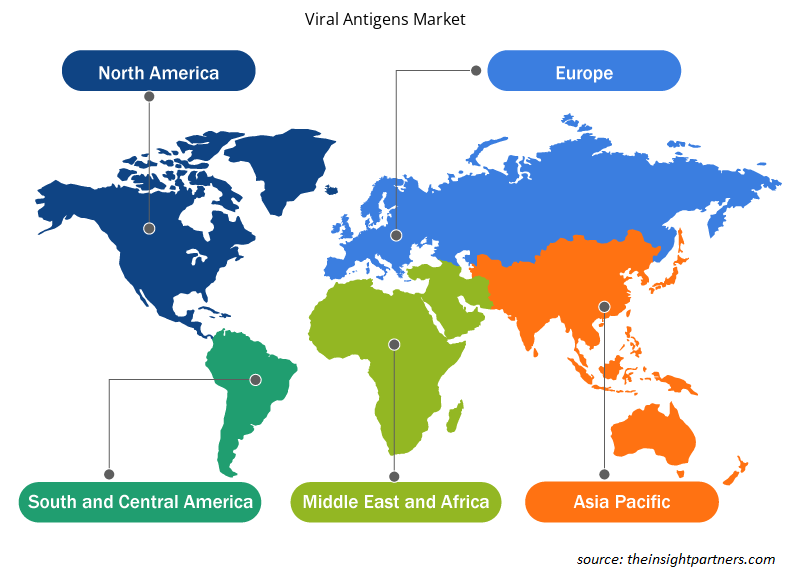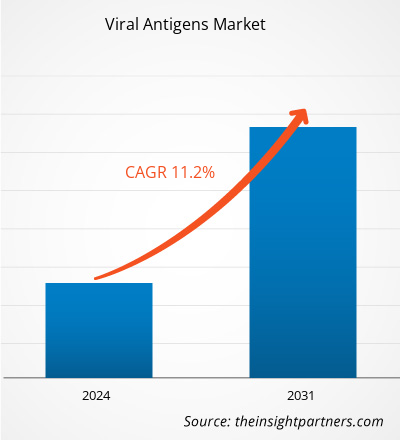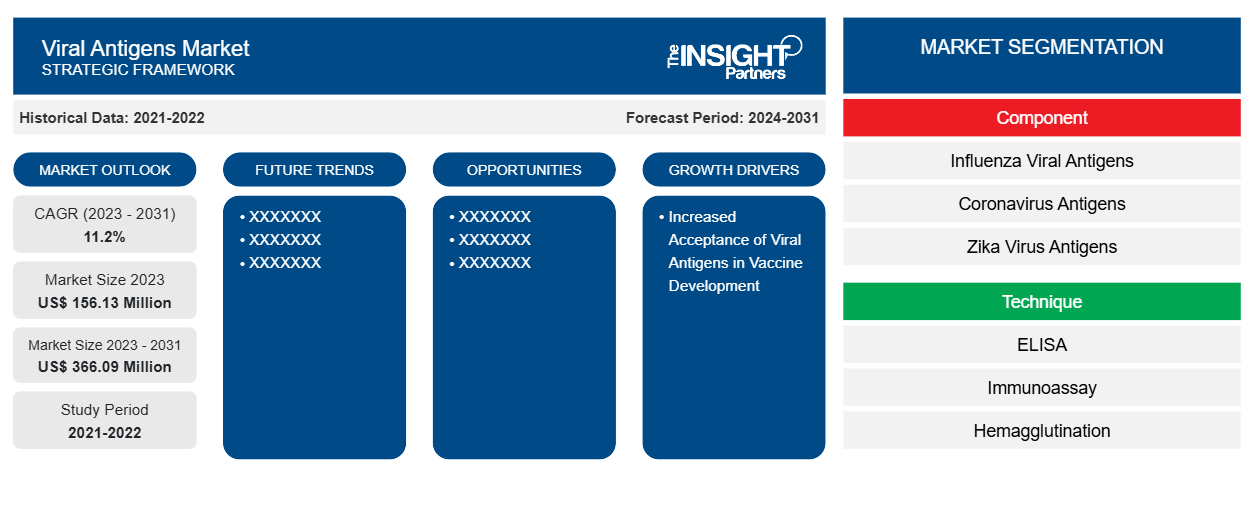El tamaño del mercado de antígenos virales se estimó en US$ 156,13 millones en 2023 y se espera que alcance los US$ 366,09 millones para 2031; se estima que registrará una CAGR del 11,2% hasta 2031. Es probable que el desarrollo de antígenos de vacunas y productos biofarmacéuticos elaborados a partir de plantas siga siendo una tendencia clave en el mercado de antígenos virales.
Análisis del mercado de antígenos virales
La creciente prevalencia de infecciones virales en todo el mundo, incluidos el VIH, la gripe, la hepatitis y virus respiratorios como el COVID-19, impulsa la demanda de antígenos virales que se utilizan en estudios de diagnóstico. Los avances en biología molecular, las iniciativas gubernamentales para el desarrollo de vacunas contra virus emergentes, el aumento de las actividades de I+D para el desarrollo de técnicas de diagnóstico y el desarrollo de vacunas, y el aumento de la inversión en la investigación de antígenos virales están impulsando el crecimiento del mercado de antígenos virales.
Descripción general del mercado de antígenos virales
Un virus puede infectar todo tipo de formas de vida, desde plantas y animales hasta arqueas y bacterias. Un antígeno viral es un veneno o sustancia tóxica administrada por un virus que induce una reacción inmunitaria en su huésped. Una proteína viral es un antígeno identificado por el genoma viral que puede reconocerse a través de una respuesta inmunológica particular. Un antígeno viral se determina mediante IFA en neutrófilos y plaquetas de la médula ósea o la sangre o en suero, saliva, lágrimas o plasma mediante ELISA. Las pruebas de amplificación nucleica también se pueden utilizar para determinar la etapa de la infección. Los mejores resultados se obtienen cuando los antígenos se miden a través de análisis de sangre o suero.
Personalice este informe según sus necesidades
Obtendrá personalización en cualquier informe, sin cargo, incluidas partes de este informe o análisis a nivel de país, paquete de datos de Excel, así como también grandes ofertas y descuentos para empresas emergentes y universidades.
-
Obtenga las principales tendencias clave del mercado de este informe.Esta muestra GRATUITA incluirá análisis de datos, desde tendencias del mercado hasta estimaciones y pronósticos.
Factores impulsores y oportunidades del mercado de antígenos virales
Mayor conciencia sobre los antígenos virales en el desarrollo de vacunas
Los antígenos virales desempeñan un papel importante en el desarrollo de vacunas, ya que son el componente que detecta el sistema inmunológico para su protección. Por ejemplo, cuando una persona se infecta con un virus, su sistema inmunológico reconoce antígenos virales específicos como extraños y genera una respuesta para eliminar el virus. Los antígenos virales en las vacunas exponen al sistema inmunológico a estos antígenos específicos de manera controlada y, por lo tanto, ayudan a la persona a desarrollar una respuesta inmunológica contra el virus. El desarrollo y uso de vacunas ha reducido en gran medida el número de enfermedades a lo largo de los años. La introducción de una variedad de nuevos tipos de vacunas ha sido posible gracias a la manipulación del ADN , ARN, proteínas y azúcares, un mayor conocimiento de la respuesta inmunológica y un gran avance en la ingeniería genética. El desarrollo de mutantes atenuados, la expresión de posibles antígenos en vectores vivos y la purificación y síntesis directa de antígenos en nuevos sistemas han mejorado significativamente la tecnología de las vacunas. Por lo tanto, se espera que una mayor aceptación de los antígenos virales en el desarrollo de vacunas impulse el mercado durante el período de pronóstico.recognises specific viral antigens as foreign and mounts a response to eliminate the virus. Viral antigens in vaccines exposes the immune system to these specific anitgens in a controlled manner and thus helping the person to develop immune response against the virus. The development and use of vaccines has greatly reduced the number of illnesses and diseases over the years. The introduction of a variety of new types of vaccines has been made possible through the manipulation of
Conciencia creciente sobre la atención sanitaria preventiva: una oportunidad para el mercado de los antígenos virales
La atención sanitaria preventiva se centra en prevenir la aparición de problemas de salud y también en diagnosticar los problemas antes de que se desarrollen síntomas o complicaciones. La vacunación desempeña un papel crucial en la atención sanitaria preventiva, ya que puede fortalecer la inmunidad de una persona contra las infecciones virales antes de que se exponga al virus. En el caso de la atención sanitaria preventiva, las vacunas desarrolladas generalmente están compuestas de antígenos virales para que el sistema inmunológico los detecte. Por lo tanto, el aumento de la concienciación sobre la atención sanitaria preventiva a través de la vacunación está impulsando el crecimiento del mercado de antígenos virales.
Análisis de segmentación del informe de mercado de antígenos virales
Los segmentos clave que contribuyeron a la derivación del análisis del mercado de antígenos virales son el componente, la técnica y el usuario final.
- Según los componentes, el mercado de antígenos virales se segmenta en antígenos virales de la influenza, antígenos del coronavirus, antígenos del virus del Zika, antígenos del virus del Ébola, antígenos del virus del dengue, antígenos virales del virus del herpes simple (HSV), antígenos virales del rotavirus, antígenos del virus de la hepatitis AE, antígenos del virus del sarampión, antígenos del virus de las paperas/parotiditis y otros. El segmento de antígenos virales de la influenza tuvo la mayor participación de mercado en 2023. Los CDC caracterizan antigénicamente alrededor de 2000 virus de la influenza cada año para comparar qué tan similares son los virus de la influenza que circulan actualmente con los utilizados en la vacuna contra la influenza y para detectar cambios en los virus de la influenza circulantes. La caracterización antigénica puede implicar la capacidad de la vacuna contra la influenza para inducir una respuesta inmune contra los virus de la influenza que circulan en humanos.HSV) Viral Antigens, Rotavirus Viral Antigens, Hepatitis A-E Virus Antigens, Measles Virus Antigens, Mumps/Parotitis Virus Antigens, and others. The influenza viral antigens segment held the largest market share in 2023. Around 2,000 influenza viruses are antigenically characterized by the CDC each year to compare how similar currently circulating influenza viruses are to those used in the influenza vaccine and to detect changes in circulating influenza viruses. Antigenic characterization may imply the capacity of the flu vaccine to induce an immune response against influenza viruses that circulate in humans.
- Por técnica, el mercado está segmentado en ELISA, inmunoensayo, hemaglutinación, radioinmunoensayo (RIA), tinción con inmunoperoxidasa, inmunofluorescencia y otros. El segmento ELISA tuvo la mayor participación del mercado en 2023.
- En términos de usuario final, el mercado está segmentado en hospitales, clínicas, laboratorios, centros de diagnóstico, bancos de sangre e institutos de investigación. El segmento de diagnóstico dominó el mercado en 2023.
Análisis de la cuota de mercado de los antígenos virales por geografía
El alcance geográfico del informe del mercado de antígenos virales se divide principalmente en cinco regiones: América del Norte, Asia Pacífico, Europa, Medio Oriente y África, y América del Sur / América del Sur y Central.
América del Norte ha dominado el mercado de antígenos virales. En América del Norte, Estados Unidos tiene una participación significativa en el mercado de terapias para la esclerosis múltiple. El crecimiento del mercado en el país está impulsado principalmente por una gran cantidad de actividades de I+D para el desarrollo de vacunas, ayudas financieras por parte de los gobiernos, otras organizaciones privadas y no privadas para campañas de vacunación y la creciente prevalencia de infecciones virales en el país. Además, se espera que la creciente conciencia sobre la atención médica preventiva impulse la adopción y aceptación de los productos durante el período de pronóstico.
Perspectivas regionales del mercado de antígenos virales
Los analistas de Insight Partners explicaron en detalle las tendencias y los factores regionales que influyen en el mercado de antígenos virales durante el período de pronóstico. Esta sección también analiza los segmentos y la geografía del mercado de antígenos virales en América del Norte, Europa, Asia Pacífico, Oriente Medio y África, y América del Sur y Central.

- Obtenga datos regionales específicos para el mercado de antígenos virales
Alcance del informe sobre el mercado de antígenos virales
| Atributo del informe | Detalles |
|---|---|
| Tamaño del mercado en 2023 | US$ 156,13 millones |
| Tamaño del mercado en 2031 | US$ 366,09 millones |
| CAGR global (2023 - 2031) | 11,2% |
| Datos históricos | 2021-2022 |
| Período de pronóstico | 2024-2031 |
| Segmentos cubiertos |
Por componente
|
| Regiones y países cubiertos |
América del norte
|
| Líderes del mercado y perfiles de empresas clave |
|
Densidad de actores del mercado de antígenos virales: comprensión de su impacto en la dinámica empresarial
El mercado de antígenos virales está creciendo rápidamente, impulsado por la creciente demanda de los usuarios finales debido a factores como la evolución de las preferencias de los consumidores, los avances tecnológicos y una mayor conciencia de los beneficios del producto. A medida que aumenta la demanda, las empresas amplían sus ofertas, innovan para satisfacer las necesidades de los consumidores y aprovechan las tendencias emergentes, lo que impulsa aún más el crecimiento del mercado.
La densidad de actores del mercado se refiere a la distribución de las empresas o firmas que operan dentro de un mercado o industria en particular. Indica cuántos competidores (actores del mercado) están presentes en un espacio de mercado determinado en relación con su tamaño o valor total de mercado.
Las principales empresas que operan en el mercado de antígenos virales son:
- Biosistemas Microbix
- LABORATORIOS BIO-RAD INC.
- Diagnóstico creativo
- Reactivos Bio Aalto Ltd.
- Biotecnologías Avanzadas Inc.
- Prospec-Tany Technogene Ltd.
Descargo de responsabilidad : Las empresas enumeradas anteriormente no están clasificadas en ningún orden particular.

- Obtenga una descripción general de los principales actores clave del mercado de antígenos virales
Noticias y desarrollos recientes del mercado de antígenos virales
El mercado de antígenos virales se evalúa mediante la recopilación de datos cualitativos y cuantitativos posteriores a la investigación primaria y secundaria, que incluye publicaciones corporativas importantes, datos de asociaciones y bases de datos. A continuación, se incluye una lista de los avances en el mercado de antígenos virales y las estrategias:
- Sino Biological Inc lanzó la colección de antígenos virales recombinantes más grande del mundo, ProVir. La línea de productos incluye una amplia gama de proteínas recombinantes de alta calidad expresadas en células de insectos y mamíferos. Estos productos se someten a pruebas rigurosas para comprobar su pureza y bioactividad. Esta cartera incluye más de 800 productos de 45 tipos diferentes y 350 cepas de virus. (Fuente: Sino Biological Inc, sitio web de la empresa, 2020)
Informe sobre el mercado de antígenos virales: cobertura y resultados
El informe “Tamaño y pronóstico del mercado de antígenos virales (2021-2031)” proporciona un análisis detallado del mercado que cubre las siguientes áreas:
- Tamaño del mercado y pronóstico a nivel global, regional y nacional para todos los segmentos clave del mercado cubiertos bajo el alcance
- Dinámica del mercado, como impulsores, restricciones y oportunidades clave
- Principales tendencias futuras
- Análisis detallado de las cinco fuerzas de Porter y PEST y FODA
- Análisis del mercado global y regional que cubre las tendencias clave del mercado, los principales actores, las regulaciones y los desarrollos recientes del mercado.
- Análisis del panorama de la industria y de la competencia que abarca la concentración del mercado, el análisis de mapas de calor, los actores destacados y los desarrollos recientes
- Perfiles detallados de empresas
- Análisis histórico (2 años), año base, pronóstico (7 años) con CAGR
- Análisis PEST y FODA
- Tamaño del mercado, valor/volumen: global, regional y nacional
- Industria y panorama competitivo
- Conjunto de datos de Excel
Informes recientes
Testimonios
Razón para comprar
- Toma de decisiones informada
- Comprensión de la dinámica del mercado
- Análisis competitivo
- Información sobre clientes
- Pronósticos del mercado
- Mitigación de riesgos
- Planificación estratégica
- Justificación de la inversión
- Identificación de mercados emergentes
- Mejora de las estrategias de marketing
- Impulso de la eficiencia operativa
- Alineación con las tendencias regulatorias























 Obtenga una muestra gratuita para - Mercado de antígenos virales
Obtenga una muestra gratuita para - Mercado de antígenos virales